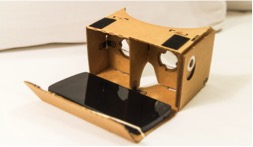A first post for 2016 aiming to start the year with a mix of fun and a serious point concerning a $29.99 virtual reality ‘toy’ that will have been Christmas present for a lot of kids. The View-Master is a toy only because it is being marketed that way, it is actually a quality product based on Google Cardboard. This is mass consumer market Virtual Reality ideal for Smart City Services!
View-Master provides a set of goggles for $29.99 into which most popular current Smart Phone fit making Virtual Reality a cost effective proposition to add value to many tasks, or to Smart Cities projects. A link in the last paragraph instructs on how to make a City weather map in Virtual Reality.


It’s not too easy to see in this photo, but there is a Smart Phone encased in the goggles providing a split image for the eyepieces. The genius of the approach is to make use of that most readily available piece of Technology; a Smart phone, to collect the images and deliver to the eyepieces.
For kids with non-techie fathers there are conventional round discs of photos, but a simple download gives the Smart Phone the ability to take photos, or download photos, before turning them into Virtual Reality scenes. Suddenly it doesn’t take huge expensive headsets to deliver Virtual Reality, instead the ubiquitously to hand Smart Phone acquires yet another useful function.
The use of pictures, which includes time lapse from Web Cams, would offer many possibilities for sharing information in a Smart City environment. In addition Virtual Reality also provides additional information when linked to IoT events, and actionable outcomes. As and example traffic and travel information on new road layouts of often includes 2D photos, how much better to be able to navigate the new junction in Virtual Reality.
For a Service Engineer receiving a call out on their Smart Phone, the notion of popping the Smart Phone into low cost Virtual Reality goggles to actually see location and other machine details makes sense.
Asset Digitization implementations can readily include Photographs for Virtual Reality along with a mass of other data aligned to the specific IoT sensor reporting the event.
View-Master is based on the Virtual Reality approach pioneered by Google under the name of ‘Google Cardboard’. The picture shows the name to be descriptive of the innovative low cost approach taken to constructing the usually prohibitively expensive V-R Goggles, or Headset. Google Cardboard was meant to be a game-changing move with a low cost mass-market uptake to encourage adoption in the consumer market.
Google offers a full range of support options including Software Developer Kits, though currently limited to Android, through to the Google Cardboard
blogs to share ideas and experiences. (View-Master also supports
 Apple iOS 6 as well as Android, suggesting that this cannot be too difficult to achieve). The notion of Cardboard goggles may seem a little weird, even whacky, but the principle of creating highly affordable mass market Virtual Reality could well become achievable by this approach.
Apple iOS 6 as well as Android, suggesting that this cannot be too difficult to achieve). The notion of Cardboard goggles may seem a little weird, even whacky, but the principle of creating highly affordable mass market Virtual Reality could well become achievable by this approach.
There is a further separate site apparently offering similar support to the Google Cardboard nominated above, but under the Chrome Browser heading, billed as Chrome Browser Virtual Reality experiments. A further useful link is the PC Advisor list of the twelve best consumer apps providing a good starting point to see some ideas of what can be achieved with the Technology. If you want to get started then there are recommendations for DoDocase as the place to buy the basic cardboard viewer, see some Apps, as well as get some support.
Over recent years many of the technologies that have transformed Business have started out as a consumer technology before being adopted by business. It would seem that Virtual Reality might be set to enter the mainstream in the same way.
Returning to conclude with the topic of Smart Cities; there is no shortage of research papers concerning the benefits that Virtual Reality can bring to Smart Cities. (try googling Virtual Reality Smart Cities to see a good selection). The drawback has, up till now, been the cost and complexity of Virtual Reality goggles, or headsets. This is a problem conveniently bypassed by the Google Cardboard approach, which though not as sophisticated a solution, does bring the cost and availability down to suit consumers, or citizens.
This paragraph is for those technically interested enough to want to try out building a Virtual Reality App for City weather forecasts using Google Cardboard. It’s fully spelt out as to how to write this App in detail by Patrick Catanzarti at Site point in a post entitled Bringing Virtual Reality to the Web using Google Cardboard.
The Internet of Things primarily provides awareness of remote events and situations that call for actions. As more and more devices provide visual data it is logical that Virtual Reality will become increasingly popular providing that a price point can be reached. View-Master and Google Cardboard bring that point within reach, and Smart Cities are a likely starting point for new Apps.


